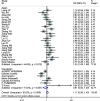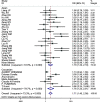Association between apolipoprotein gene polymorphisms and hyperlipidemia: a meta-analysis
- PMID: 33836655
- PMCID: PMC8034140
- DOI: 10.1186/s12863-021-00968-1
Association between apolipoprotein gene polymorphisms and hyperlipidemia: a meta-analysis
Abstract
Background: Hyperlipidemia plays an important role in the etiology of cardio-cerebrovascular disease. Over recent years, a number of studies have explored the impact of apolipoprotein genetic polymorphisms in hyperlipidemia, but considerable differences and uncertainty have been found in their association with different populations from different regions.
Results: A total of 59 articles were included, containing in total 13,843 hyperlipidemia patients in the case group and 15,398 healthy controls in the control group. Meta-analysis of the data indicated that APOA5-1131 T > C, APOA1 -75 bp, APOB XbaI, and APOE gene polymorphisms were significantly associated with hyperlipidemia, with OR values of 1.996, 1.228, 1.444, and 1.710, respectively. All P-values were less than 0.05.
Conclusions: Meta-analysis of the data indicated that the C allele of APOA5 1131 T > C, the A allele at APOA1-75 bp, the APOB XbaI T allele, and the ε2 and ε4 allele of APOE were each a risk factor for susceptibility for hyperlipidemia.
Keywords: APO; Apolipoprotein; Gene polymorphism; Hyperlipidemia; Meta-analysis.
Conflict of interest statement
We declare that none of the work contained in this manuscript is published in any language or currently under consideration at any other journal, and there are no conflicts of interest to declare.
Figures










Similar articles
-
The influence of apolipoprotein B and E gene polymorphisms on the response to simvastatin therapy in patients with hyperlipidemia.Chin Med Sci J. 2003 Mar;18(1):9-13. Chin Med Sci J. 2003. PMID: 12901521
-
Influence of polymorphisms for apolipoprotein B (ins/del, XbaI, EcoRI) and apolipoprotein E on serum lipids and apolipoproteins in a Javanese population.Genet Epidemiol. 1994;11(1):19-27. doi: 10.1002/gepi.1370110103. Genet Epidemiol. 1994. PMID: 8013886
-
Polymorphisms in apolipoprotein E and apolipoprotein A-V do not influence the lipid response to rosuvastatin but are associated with baseline lipid levels in Chinese patients with hyperlipidemia.J Clin Lipidol. 2012 Nov-Dec;6(6):585-92. doi: 10.1016/j.jacl.2012.02.005. Epub 2012 Feb 18. J Clin Lipidol. 2012. PMID: 23312054
-
Apolipoprotein E polymorphisms in frontotemporal lobar degeneration: a meta-analysis.Alzheimers Dement. 2013 Nov;9(6):706-13. doi: 10.1016/j.jalz.2012.10.013. Epub 2013 May 18. Alzheimers Dement. 2013. PMID: 23688578
-
Association between apolipoprotein E gene polymorphism and depression.J Clin Neurosci. 2015 Aug;22(8):1232-8. doi: 10.1016/j.jocn.2015.02.012. Epub 2015 May 12. J Clin Neurosci. 2015. PMID: 25979253 Review.
Cited by
-
Association of CELSR2, APOB100, ABCG5/8, LDLR, and APOE polymorphisms and their genetic risks with lipids among the Thai subjects.Saudi J Biol Sci. 2023 Feb;30(2):103554. doi: 10.1016/j.sjbs.2022.103554. Epub 2022 Dec 26. Saudi J Biol Sci. 2023. PMID: 36619676 Free PMC article.
-
Apolipoprotein E Gene Polymorphism and Coronary Artery Disease Risk Among Patients in Northwest China.Pharmgenomics Pers Med. 2021 Dec 7;14:1591-1599. doi: 10.2147/PGPM.S338285. eCollection 2021. Pharmgenomics Pers Med. 2021. PMID: 34908864 Free PMC article.
-
Association between Apo B, LDL-R and PCSK9 gene polymorphisms with coronary artery diseases in Egyptians.Mol Biol Rep. 2024 Jun 14;51(1):752. doi: 10.1007/s11033-024-09607-1. Mol Biol Rep. 2024. PMID: 38874786
-
The Apo gene's genetic variants: hidden role in Asian vascular risk.Neurogenetics. 2024 Jul;25(3):157-164. doi: 10.1007/s10048-024-00757-9. Epub 2024 Apr 16. Neurogenetics. 2024. PMID: 38625441 Review.
-
APOE in the bullseye of neurodegenerative diseases: impact of the APOE genotype in Alzheimer's disease pathology and brain diseases.Mol Neurodegener. 2022 Sep 24;17(1):62. doi: 10.1186/s13024-022-00566-4. Mol Neurodegener. 2022. PMID: 36153580 Free PMC article. Review.
References
Publication types
MeSH terms
Substances
Grants and funding
LinkOut - more resources
Full Text Sources
Other Literature Sources
Miscellaneous
